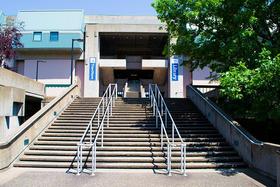- Lake Tahoe Community College promotes learning and enrichment for our students and community through exemplary educational experiences provided in a uniquely supportive environment.
School Highlights
Lake Tahoe Community College serves 8,526 students (9% of students are full-time).
Minority enrollment is 52% of the student body (majority Hispanic), which is less than the state average of 77%.
Quick Facts (2025-26)
- Enrollment: 8,526 students
- In-state tuition: $1,221
- Out-state tuition: $6,642
- Minority enrollment: 52%
- Source: Integrated Postsecondary Education Data System (IPEDS)
School Overview
The teacher population of 168 teachers has stayed relatively flat over five years.
Lake Tahoe Community College
(CA) Community College Avg.
Carnegie Classification
Associate's Colleges: Mixed Transfer/Career & Technical-High Nontraditional
Baccalaureate/Associate's Colleges: Associate's Dominant
Institution Level
At least 2 but less than 4 years
At least 2 but less than 4 years
Institution Control
Public
Public
Total Faculty
168 staff
315 staff
School Calendar
Student Body
The student population of Lake Tahoe Community College has grown by 230% over five years.
The Lake Tahoe Community College diversity score of 0.68 is less than the state average of 0.70. The school's diversity has declined by 5% over five years.
Total Enrollment
8,526 students
9,796 students
Student-Teacher Ratio
51:1
32:1
# Full-Time Students
793 students
1,259 students
# Part-Time Students
7,733 students
8,537 students
# Enrollment Undergraduate
852 students
242 students
# Full-Time Undergraduate Students
793 students
1,250 students
# Full-Time Graduate Students
n/a
63 students
# Part-Time Undergraduate Students
7,733 students
8,299 students
# Part-Time Graduate Students
n/a
10 students
Total Dormitory Capacity
30 students
121 students
% American Indian/Alaskan
1%
n/a
% Asian
8%
13%
% Hispanic
27%
47%
% Black
4%
7%
% White
48%
23%
% Hawaiian
1%
1%
% Two or more races
3%
5%
% Non Resident races
n/a
1%
% Unknown races
8%
3%
Diversity Score
0.68
0.70
College Completion Rate (Students who graduate in less than 4 years)
34%
42%
College Completion Rate (Students who graduate in 4 years or more than 4 years)
n/a
43%
Average Graduate Earnings (10 Years)
$30,500
$34,700
Tuition and Acceptance Rate
The public in-state tuition of $1,221 is less than the state average of $1,516. The in-state tuition has grown by 7% over four years.
The public out-state tuition of $6,642 is less than the state average of $6,779. The out-state tuition has declined by 17% over four years.
In-State Tuition Fees
$1,221
$1,516
Out-State Tuition Fees
$6,642
$6,779
% Students Receiving Some Financial Aid
63%
85%
Median Debt for Graduates
n/a
$10,500
Median Debt for Dropouts (Year 2011)
$3,500
$4,658
Acceptance Rate
n/a
93%
Source: 2024 (or latest year available) Integrated Postsecondary Education Data System (IPEDS) , School Administrators
School Notes
- School Mascot: Coyote
- At 6,229 feet above sea level, Lake Tahoe Community College, set in the heart of South Lake Tahoe, is the highest college in California. Opened in 1975, approximately 4,000 students come through the doors each quarter. Beyond the classrooms and labs, the 164-acre wooded campus features a 192-seat black box theater, extensive art labs and a demonstration garden. A 26,000 square foot gymnasium with a dance studio and fitness education center and a student center, which includes a caf?, Internet terminals, and teaching kitchens for the culinary arts program were opened in 2002. In 2004, the college will break ground for a new library and art gallery. The college offers certificates and associate degrees from culinary arts to computer studies. With our 49 full-time faculty members students come first. Outdoor recreation can be found all year in South Lake Tahoe, a town of about 24,000 residents. Students are within minutes of three ski resorts. There are 14 resorts in all around the lake. Summer brings water sports, fishing, hiking, camping and an extensive network of mountain biking trails. The sun shines an average 75 percent or 274 days each year giving students plenty of opportunities to get out and explore the Sierra Nevada. Lake Tahoe Community College promotes learning and enrichment for our students and community through exemplary educational experiences provided in a uniquely supportive environment. Lake Tahoe Community College will provide outstanding educational opportunities for every student in a personal learning community. The college is fully accredited by the Western Association of Schools and Colleges, an institutional accrediting body recognized by the Council for Higher Education Accreditation and the U.S. Department of Education.
Frequently Asked Questions
How much does Lake Tahoe Community College cost?
Lake Tahoe Community College's tuition is approximately $1,221 for In-State students and $6,642 for Out-State students.
Recent Articles

The Rise of Technical and Vocational Training in 2025
Explore the 2025 surge in technical and vocational training—enrollment, policy, costs, and why this path is gaining ground for students and parents.

Stackable Credentials: How Community Colleges Advance Careers
Discover how community colleges use stackable credentials to build career pathways, boost earnings, and enable lifelong learning in 2025.

High-Paying Jobs You Can Get with a Community College Degree
Discover top high-paying careers you can launch in 2025 with a community college (associate) degree and high-growth credentials in tech, healthcare and trades.










